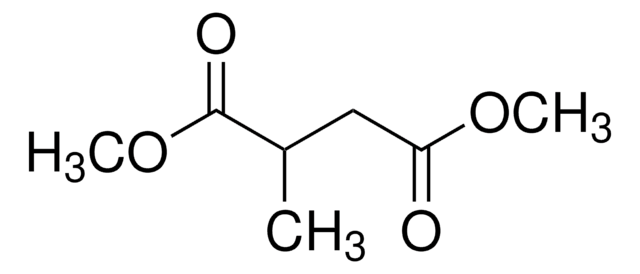W239607
Dimethyl succinate
98%, FG
Synonyme(s) :
Dimethyl butanedioate, Succinic acid dimethyl ester
About This Item
Produits recommandés
Source biologique
synthetic
Niveau de qualité
Qualité
FG
Halal
Kosher
Conformité réglementaire
EU Regulation 1334/2008 & 178/2002
FDA 21 CFR 117
FDA 21 CFR 172.515
Pression de vapeur
0.3 mmHg ( 20 °C)
Pureté
98%
Température d'inflammation spontanée
689 °F
Limite d'explosivité
8.5 %
Indice de réfraction
n20/D 1.419 (lit.)
Point d'ébullition
200 °C (lit.)
Pf
16-19 °C (lit.)
Densité
1.117 g/mL at 25 °C (lit.)
Application(s)
flavors and fragrances
Documentation
see Safety & Documentation for available documents
Allergène alimentaire
no known allergens
Propriétés organoleptiques
green; fruity; floral; sweet
Chaîne SMILES
COC(=O)CCC(=O)OC
InChI
1S/C6H10O4/c1-9-5(7)3-4-6(8)10-2/h3-4H2,1-2H3
Clé InChI
MUXOBHXGJLMRAB-UHFFFAOYSA-N
Vous recherchez des produits similaires ? Visite Guide de comparaison des produits
Catégories apparentées
Description générale
Application
- Metabolic Bypass Rescues Aberrant S-nitrosylation-Induced TCA Cycle Inhibition and Synapse Loss in Alzheimer′s Disease Human Neurons.: This research discusses the role of metabolic intermediates like Dimethyl succinate in bypassing biochemical blocks in Alzheimer′s disease, offering potential therapeutic avenues (Andreyev et al., 2024).
- Update to RIFM fragrance ingredient safety assessment, dimethyl succinate, CAS Registry Number 106-65-0.: A comprehensive safety assessment of Dimethyl succinate as a fragrance ingredient, highlighting its toxicological profile and safe usage parameters (Api et al., 2023).
Mention d'avertissement
Warning
Mentions de danger
Conseils de prudence
Classification des risques
Eye Irrit. 2
Code de la classe de stockage
10 - Combustible liquids
Classe de danger pour l'eau (WGK)
WGK 1
Point d'éclair (°F)
201.2 °F - closed cup
Point d'éclair (°C)
94 °C - closed cup
Équipement de protection individuelle
Eyeshields, Gloves, type ABEK (EN14387) respirator filter
Certificats d'analyse (COA)
Recherchez un Certificats d'analyse (COA) en saisissant le numéro de lot du produit. Les numéros de lot figurent sur l'étiquette du produit après les mots "Lot" ou "Batch".
Déjà en possession de ce produit ?
Retrouvez la documentation relative aux produits que vous avez récemment achetés dans la Bibliothèque de documents.
Les clients ont également consulté
Notre équipe de scientifiques dispose d'une expérience dans tous les secteurs de la recherche, notamment en sciences de la vie, science des matériaux, synthèse chimique, chromatographie, analyse et dans de nombreux autres domaines..
Contacter notre Service technique










